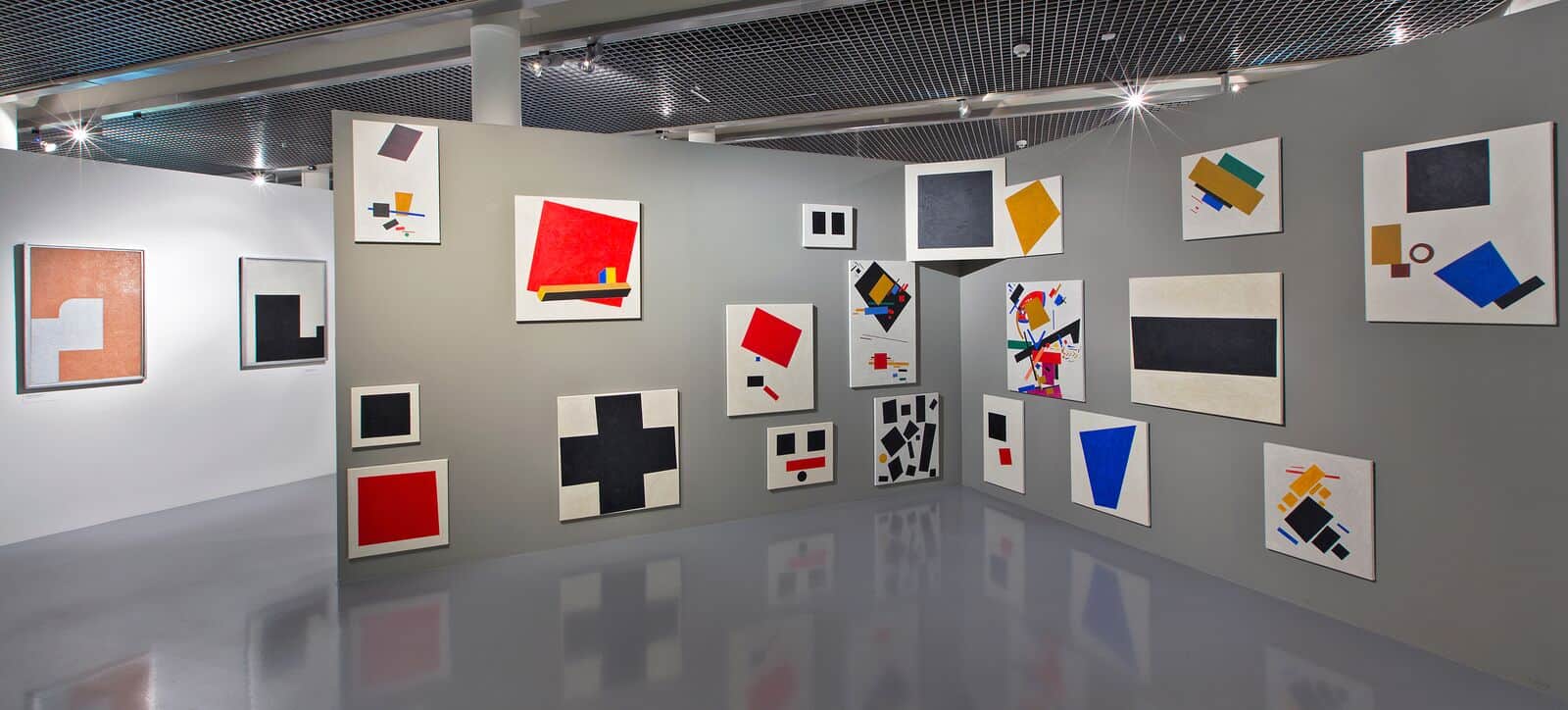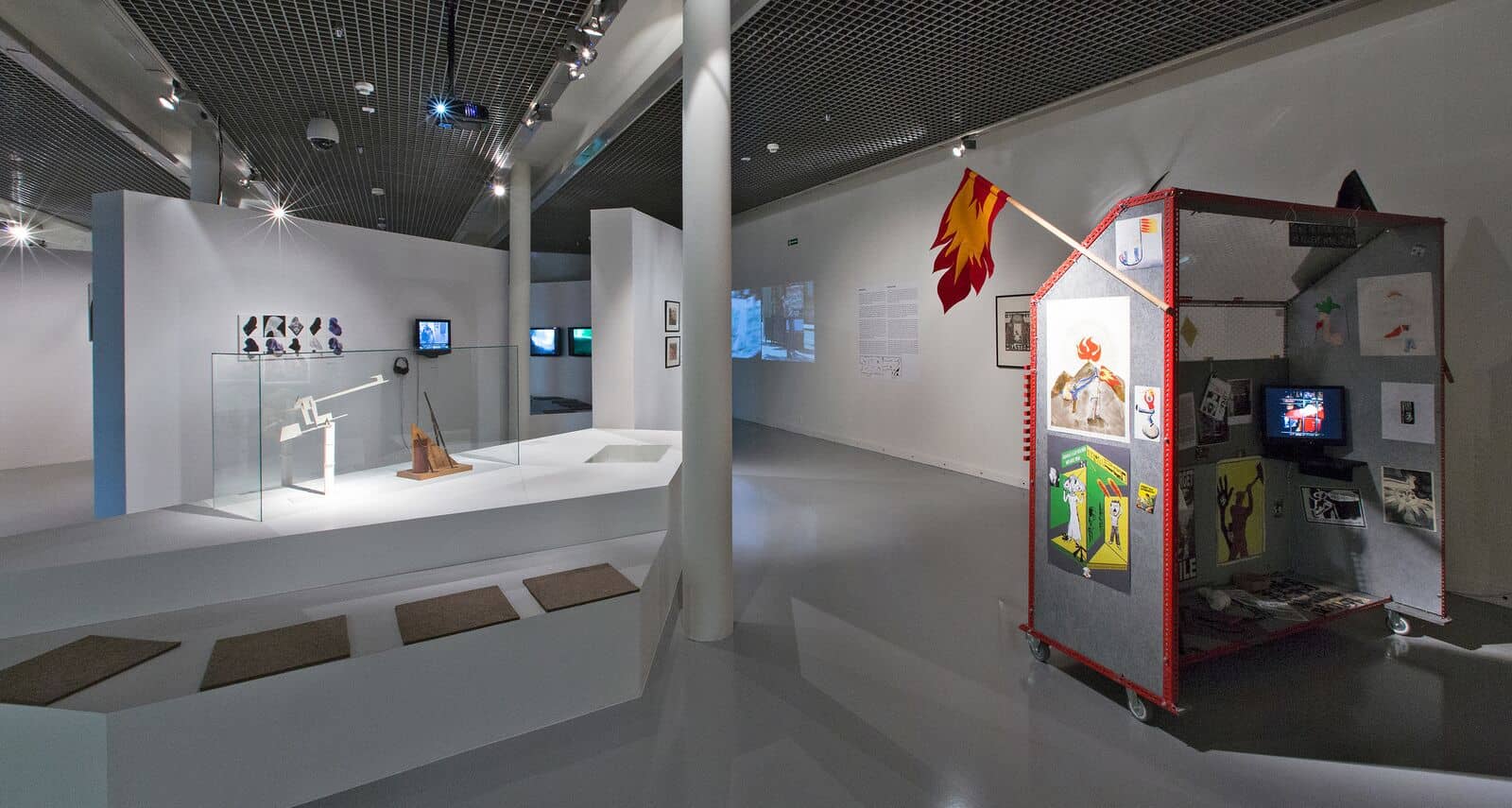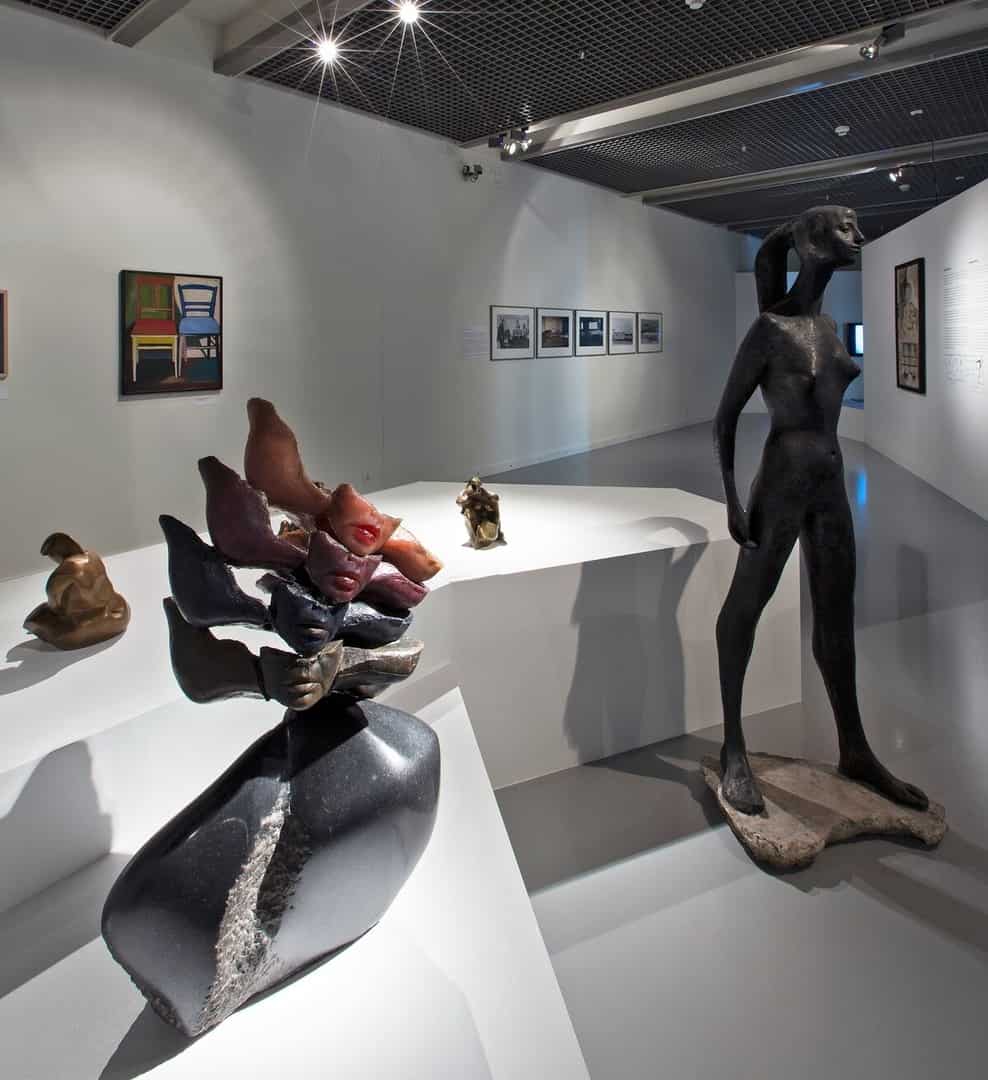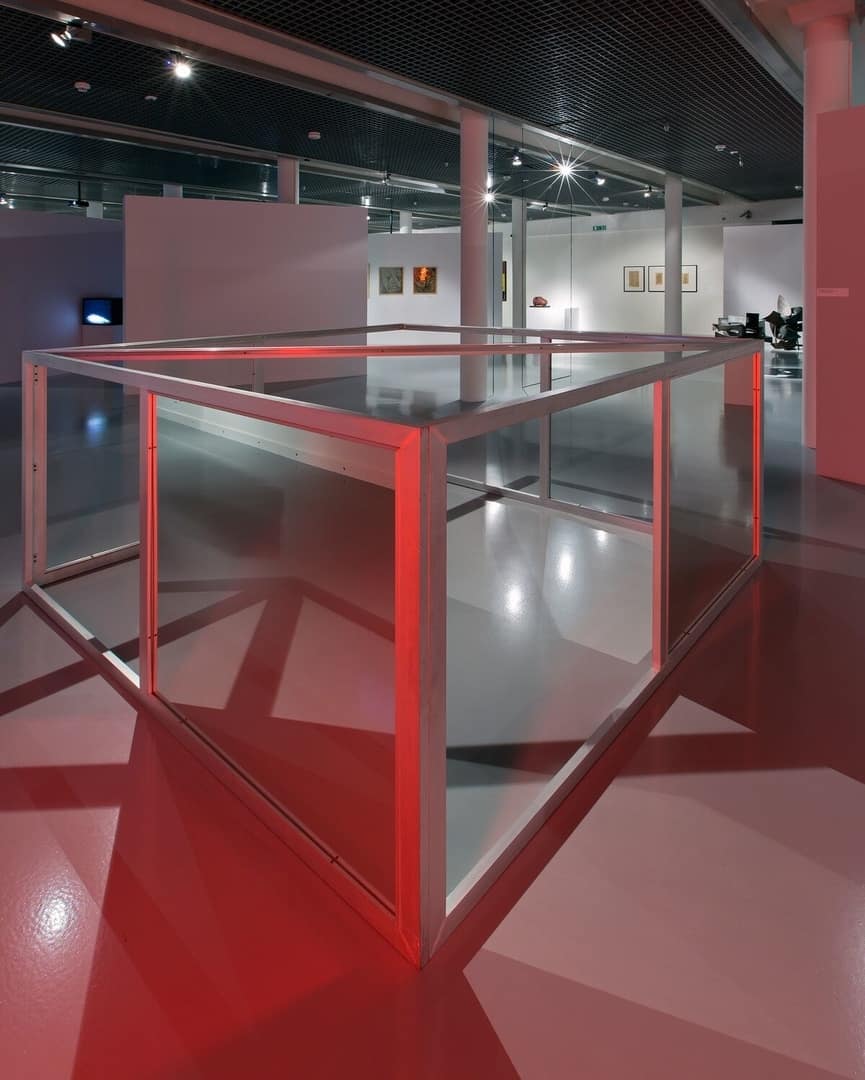In February 1931 the International Collection of Modern Art of the “a.r.” group was opened to the public at the J. and K. Bartoszewicz City Museum of History and Art. The collection was to become the foundation of the Muzeum Sztuki in Łódź. In 2016, on the occasion of the 85th anniversary of this event, we have the pleasure to talk to the Museum’s director – Jarosław Suchan.

Atlas of Modernity, display view, photo P. Tomczyk, courtesy of Muzeum Sztuki in Łódź
MK: On 15 February 1931 the International Collection of Modern Art of the “a.r.” group was opened to the public at the J. and K. Bartoszewicz Municipal Museum of History and Art. The collection was to become the roots of Muzeum Sztuki in Łódź. What was so special about this collection being created?
Jarosław Suchan: First of all, it was one of the first avant-garde art collections in the world which was open to the public. Until then, avant-garde art could only be seen at the so-called art culture museums which were opened in Russia during the October Revolution and in the famous Abstrakt Kabinett designed by El Lissitzky for Provinzialmuseum in Hanover in 1927. These attempts, however, proved unsuccessful – the Soviet museums were opened for just a few years, while the avant-garde art collection in Hanover was destroyed by the Nazis in 1936. In 1929 in New York, the Museum of Modern Art was created and is considered the very first museum of modern art. However, it is worth remembering that it was only in 1936 when avant-garde works were included in its permanent exhibition. Before that, the MoMA presented impressionist and post-impressionist paintings. So, in fact, we presented avant-garde art five years earlier.
The “a.r.” group collection was so extraordinary not only due to its really early beginnings. The way it was created was exceptional in itself. Just to remind you: it was Władysław Strzemiński, a key figure of the Polish avant-garde, who put forward the idea to create a collection which presented the most recent phenomena in the European art. Strzemiński lived in Russia during the October Revolution, where he was involved in the process of creation of art culture museums, which I mentioned before. He returned to Poland in 1921 and, since then, he planned to recreate such kind of museums in his home country. However, it was only in 1929 when the municipal authorities of Łódź offered the space in the newly created Museum which could be used for presenting modern art collection. This allowed Strzemiński’s idea to come to life. He started to collect pieces of modern art together with other members of the newly created avant-garde “a.r.” group: his wife Katarzyna Kobro – a prominent constructivist sculptor, Henryk Stażewski – a painter who also belonged to the constructivist movement, as well as two avant-garde poets – Julian Przyboś and Jan Brzękowski, the latter working in Paris. Over ten years they managed to collect 112 works of art by the most prominent European artists of that era, including Max Ernst, Hans Arp, Fernand Leger, Kurt Schwitters, Pablo Picasso, Alexander Calder, Theo Van Doesburg, Georges Vantongerloo, Prampolini, Torres-Garcia and many others. What is important – all these artists decided to donate their works without being paid for them. This is why that collection was so unique – it is a perfect manifestation of generosity and solidarity of international avant-garde.

Atlas of Modernity, display view, photo P. Tomczyk, courtesy of Muzeum Sztuki in Łódź
MK: How did it happen that a collection of works by international avant-garde artists found its home in Łódź – a city which, back then, was associated with the development of industry rather than a cultural centre?
JS: At the beginning, Strzemiński tried to gather and present such a collection in Warsaw. However, this proposal proved too revolutionary for the city. The current socialist municipal authorities of Łódź took more favourable approach towards the whole idea. One of the councillors, Przecław Smolik, was the most avid proponent of displaying the collection in a museum in Łódź. It is worth mentioning that Łódź was a rather new city, it did not carry such heavy historical burden as Warsaw, Kraków or Poznań. This may have been the reason for its openness to such revolutionary initiatives. Concentration of industry gave birth to a modern social structure with new bourgeoisie, who did not really want to build their cultural identity based on references to the past. Last but not least, Łódź was a really cosmopolitan city. Apart from the Poles, there were Russians, Germans, Jews, as well as others. They came to the city from all over Europe, attracted by the opportunity to become rich easily and quickly. This was probably another reason for the local society being more open to new ideas.
MK: The collection of Muzeum Sztuki in Łódź originated in the atmosphere of modernist utopia. Artists selflessly donated their works and the only thing they wanted was for these works to be presented to wider audience. Their goal was to make different nations more familiar with one another and to tighten relationships between them through spiritual culture. How can we present avant-garde works today, when the belief that art can change the surrounding reality is being undermined?
There is, however, one element of Strzemiński’s philosophy, which is truly worth remembering. It is his belief in a fundamentally educational and emancipatory role of museums. This role is not only about teaching the history of art for its own sake, but rather about developing societies. This is how we understand our role today – we are supposed to create favourable conditions in which our audience, by being exposed to art, develops the ability to look at the world critically and think about the world in the same way. Thereby, we should help people cross the limits which are imposed on their thinking by the hegemony of Debordian spectacle.
JS: The primary goal which Strzemiński wanted to achieve by displaying “a.r.” group’s collection was to raise the level of “artistic awareness” of their audiences, so that they would be able to understand the principles discovered and created through modern art. Strzemiński believed that in this way he would be able to provoke their desire for making the world compliant with these art-based principles. These were obviously utopian ideas. We could even say that his belief in a single correct order to which everybody and everything should be subjected was totalist to some extent. It is impossible to propagate such ideas nowadays. There is, however, one element of Strzemiński’s philosophy, which is truly worth remembering. It is his belief in a fundamentally educational and emancipatory role of museums. This role is not only about teaching the history of art for its own sake, but rather about developing societies. This is how we understand our role today – we are supposed to create favourable conditions in which our audience, by being exposed to art, develops the ability to look at the world critically and think about the world in the same way. Thereby, we should help people cross the limits which are imposed on their thinking by the hegemony of Debordian spectacle.
Art cannot exert such influence independently, even if it is rooted in the avant-garde really deeply. The works presented as relics of the past or, on the other hand, as elements of the rich people’s lifestyle cannot provoke critical thinking and emancipate viewer’s gaze. In order for this to happen, we need to create constellations in which works, no matter when they were created, are perceived as relevant to the contemporary reality and relate to life of every individual visitor. This is what we try to achieve in our museum; firstly, by experimenting with the display of our collections and, secondly, through our temporary exhibitions programme. In temporary exhibitions, we confront avant-garde art with current artistic practices and questions important for contemporary audience.
MK: Władysław Strzemiński wrote: “The difference between a museum and an exhibition is about eliminating randomness to the greatest possible extent. An exhibition depicts a single moment of an artistic life. A museum presents evolution and relationships between different movements. An exhibition is about creating a one-time aesthetic impression. A museum is mostly about education; it allows to present trends developing in every era, as well as the components which constitute the real art, prominent for a given period.” Do you agree with such division of roles?
JS: I think that such distinction was important in the times of Strzemiński, but we do not really need it today. A place where people could see the evolution of art, leading to its most modern forms, used to be important for strategic purposes – it stimulated the process of historical legitimization of the avant-garde. This goal is not so important anymore. This is why about ten years ago, we stopped shaping our collections’ display in a way it resembled a lecture on the chronology of art history. There are other museums and hundreds of popular books which took on this role. As I already mentioned, our goal is to show that works of art, no matter when they were created, have an ability to evoke crucial contemporary questions, ideas and emotions. We want to actualize this potential. In this respect, we do not differentiate between permanent and temporary exhibitions.
…our goal is to show that works of art, no matter when they were created, have an ability to evoke crucial contemporary questions, ideas and emotions. We want to actualize this potential. In this respect, we do not differentiate between permanent and temporary exhibitions.
MK: Modern art often seems difficult and incomprehensible for many potential viewers. How can modern art reach these people without being perceived as “entertainment for the unprepared” (expression used by one of the directors of Muzeum Sztuki in Łódź – Ryszard Stanisławski)?
JS: First of all, we need to make continuous effort to convince people that places where modern art is presented are really for everybody, rather than being reserved for educated elite who possesses some sort of secret knowledge. Another thing is that we need to continuously “undrill” people (as Grotowski said). The problem is not about the wide audience lacking preparation or education, but rather that they are prepared in the wrong way. Their education is based on anachronist and schematic ideas on art, its aims, and the value of its various manifestations. Therefore, it is crucial to uproot false beliefs and expectations which prevail in our societies. Many people get frustrated because these expectations are not satisfied in such places like our museum. Things they see there do not match their perception of art. Convincing the audience to abandon these beliefs is half of the story. This is why we tell them: you can call this art or not. This is not important here. The crucial thing is: does what you see here affect you personally in some way? We do everything we can to make it happened.
…you can call this art or not. This is not important here. The crucial thing is: does what you see here affect you personally in some way? We do everything we can to make it happened.

Atlas of Modernity, display view, photo P. Tomczyk, courtesy of Muzeum Sztuki in Łódź
MK: In 2008, the new ms2 building was opened. It is situated right next to the shopping mall. In your opinion, does this location influence the way the museum functions?
JS: The location definitely influences our institution but not in an obvious way. People who come to the mall to do their shopping do not run to our museum straightaway in order to “consume” art. It does not work this way. Therefore, the accusations of commercialization we faced after moving to this place are completely groundless. It is just the opposite. Being here, we disturb the order of things imposed by market and the world of consumption. What you can see and experience in our museum is so different from the things you see in a shopping mall, that our museum works like Brecht’s V-effect. Our mere presence undermines the logic of a vicious circle of production and consumption and proves that totally different values may matter in people’s lives. We try to prepare people to perceive reality in a way which, for sure, does not give rise to desires that fuel the machinery of the free market. Such perception has the opposite effect. It gives people courage to live their lives outside of the scenarios imposed by the hegemonic ideology.
MK: It is now possible to take a virtual tour of the Muzeum Sztuki in Łódź through Google Art Project. A great portion of the museum’s collection has been digitalized and made available online. Apart from that, the museum started cooperating with Wikipedia writers. In your opinion, is your online presence a necessity imposed by the realities of the contemporary world or is it rather an opportunity to redefine the meaning of museums as cultural institutions?
JS: Internet is a part of our “natural environment” and there is no way to ignore it completely. For us, it is mainly a platform through which we can communicate with our audience. I still believe that museum collections available online will not totally replace traditional museums. This is not about fetishisation of the moment of “communion” with an original artwork but rather about the unique kind of aesthetic experience which museums offer and which is not possible to enjoy in virtual reality. This is all about one simple fact – in a museum objects (even if these are screened videos) are arranged in a space, they occupy it and force visitors to move around. We can say that such “peripatetic” way of engaging with objects determines the uniqueness of museums and distinguishes watching exhibitions in real space from other ways of experiencing culture – reading a book, watching a movie in a cinema or listening to a concert in a philharmonic hall. It seems more somatic.
MK: What are the future plans for the Muzeum Sztuki in Łódź?
JS: Next year we will celebrate the centenary of the avant-garde in Poland and we would like to develop our programme for the next two years around this anniversary. There is also a political context to it. It is about trying to challenge the politics of memory which currently assumes a dominant role in our country. This official politics promotes the conception of national heritage which it defines in anachronic and simplistic way. There is no space for phenomena which destroy traditionalist ideas about the Polish past. Through our planned exhibitions we want to show that revolutionary and modernization projects developed by avant-garde are also part of our history. We wish to manifest that this is also our “national heritage” to which we should refer while creating models and points of reference for our contemporary community.

Atlas of Modernity, display view, photo P. Tomczyk, courtesy of Muzeum Sztuki in Łódź

Atlas of Modernity, display view, photo P. Tomczyk, courtesy of Muzeum Sztuki in Łódź

Atlas of Modernity, display view, photo P. Tomczyk, courtesy of Muzeum Sztuki in Łódź

Atlas of Modernity, display view, photo P. Tomczyk, courtesy of Muzeum Sztuki in Łódź












